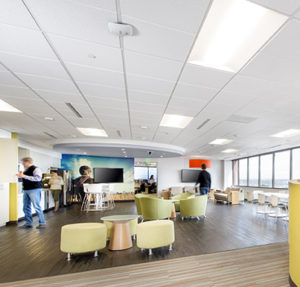There are new commercial lighting code requirements for office buildings in metro Denver. The International Energy Conservation Code is a set of regulations enacted to create or enhance energy-efficient office building systems, including mechanical, lighting and power.
“This comprehensive energy conservation code establishes minimum regulations for energy-efficient buildings using prescriptive and performance-related provisions,” states the International Code Council’s website.
That’s a pretty sweeping declaration, the intent of which can lead to significant confusion for the nontechnical minded. Fortunately, the ICC boasts that navigating the code is relatively easy for those users who do embrace technology, like engineers and building owners.
The gist here is that the code is the latest and best version of the ICC’s push for sustainability and public safety.
The IECC rolls out a revision of the code every three years, the adoption of which is solely at the discretion of any given municipality. The city of Denver adopted the 2015 version of the code late last year, one of only a handful of municipalities metrowide to step up to the revision.
With any new building code revision, there is inevitable confusion and at least some consternation among the parties responsible for interpreting it, adopting it and enforcing it. The commercial lighting portion of the 2015 IECC is no exception. To understand its impact, let’s start with the broad strokes of what it requires for office buildings.
POWER DENSITY
Existing and new buildings in Denver are required to reduce total watts per square foot. Lighting power density reduction is a way to instantly lower consumption across the board.
CONTROLS
New time clock controls and occupancy sensors are required as part of the performance-based provision of the code. That is, a number of new controls and sensors will mitigate “over fitting” of office spaces by regulating natural light levels in any given area.
Self-described daylight controls are dimming fixtures installed near windows and skylights adjacent to work areas, which automatically decrease manufactured overhead light when natural light becomes adequate for typical workplace tasks.
adjacent to work areas, which automatically decrease manufactured overhead light when natural light becomes adequate for typical workplace tasks.
The seemingly omnipresent open plan office requires more stringent lighting restrictions. Although there has been significant pushback on fully open office spaces in favor of hybrid styles, lighting options must adhere to either fully manual controls for open areas, or a mix of half automatic and half “manual on.”
Night lighting will not be permitted under the new code. Nonadjustable occupancy switches, more commonly referred to as motion sensors, are required for typical office suites. The only way for overhead lighting to switch on, in this case, is when a person triggers the sensors.
MECHANICAL
The new code requires that upgraded mechanical equipment be offset by a reduction in lighting power consumption. This applies primarily to remodeled office spaces. If this type of space requires a significant electrical service for new mechanical equipment, the standard electrical loads for power in any given suite must be deceased to compensate for the addition mechanical load.
COMISSIONING
Although it has many meanings to those in the design and construction industry, “commissioning” as it relates to lighting power generally is a qualitycontrol process in which a third party reviews and approves the electrical design before a new building is delivered to its owner, or a remodeled space is ready for occupancy. Under the 2015 IECC, commissioning is required for all commercial projects.
ALTRUISM COMES AT A COST
Building owners and property managers know that a safe and healthy workplace is at the core of tenant retention. Without delving too deeply into workplace trends or office design, it is the human factor – the quality of life – that most often can dictate tenant satisfaction and subsequent retention.
The manner in which people interact and collaborate within any given building lobby or office suite in today’s commercial marketplace can supersede design and even location. So again, health and safety are the foundation on which owners can build their brand and overall tenant satisfaction. The 2015 IECC promotes the improvement of that foundation.
The pragmatic side of that equation is that landlords must obey the new code requirements in order to obtain building permits. And that’s not cheap.
The 2015 IECC code leverages innovative technologies that were not fully available in 2012. Almost certainly, the 2018 code will introduce new and improved products and methods of lighting power that we don’t know about yet. For municipalities that choose to adopt the new code, there is a significant expense in upgrading obsolete products and systems or choosing new ones to meet compliance.
State-of-the-art fixtures, switches and sensors cost more because they’re new and perform at a higher level. It would behoove landlords to standardize new equipment in remodels rather than mix and match pieces and parts from different manufacturers. Although this certainly adds yet another level of expense, repair and replacement outlays at the front end can be eased by reduced energy costs over time. And it’s better for the environment.
Commissioning can cost owners 14 cents to $1 per square foot or more. That is a staggering cost by any measure. All office remodel projects in Denver require electrical commissioning and most require some level of mechanical commissioning as well. While this type of “soft cost” may be difficult to recover, landlords can take comfort in the notion that their buildings and tenant spaces have been formally inspected and tested for functional performance. Aside from the obvious benefit of having the most efficient and sustainable systems available, landlords who have complied with the code have a certified marketing edge over those who have not.
Forward-thinking municipalities understand that technology is the glue that holds the 2015 IECC code together, and technology isn’t going away. It’s just a plus for all parties involved when technology is the driver for both life-safety and energy conservation. It’s also good business.